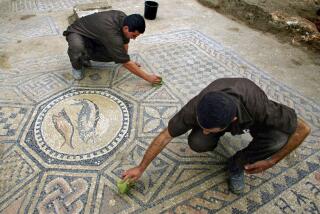In Search of Jesus’ Tomb
Christian faithful have been convinced that the Church of the Holy Sepulcher in Jerusalem marks the site of Jesus’ burial ever since Byzantine Emperor Constantine erected the church in the year 325, making it the holiest site in Christendom.
But experts have feared that Christ’s tomb itself had been destroyed by the earthquakes that have struck the site over the intervening millenniums. And many question whether Constantine was correct in concluding that the church marks the true site of the burial.
However, research conducted over the last 10 years by British archeologist Martin Biddle suggests that the tomb may remain intact inside the edicule, the small interior shrine originally built in the 4th century to protect the rock-cut tomb.
The edicule was rebuilt in the 11th, 16th and 19th centuries and Biddle’s explorations indicate that--contrary to the beliefs of scholars--the four edicule structures are nestled inside one another like Russian matryoshka dolls.
“Before we started, nobody believed that,” Biddle said. “We’ve shown that to be true.”
The Rev. Jerome Murphy-O’Connor of the Dominican Ecole Biblique in Jerusalem calls Biddle’s discovery important. “If it were taken apart very carefully, like peeling an onion, one could see the various periods,” he said.
Biddle’s studies, recounted in his book “The Tomb of Christ,” published in 1999 by Sutton, are the focus of “Secrets of the Dead,” to be broadcast Tuesday at 8 p.m. on KCET-TV.
Because Biddle’s work was performed without disturbing the shrine, most of his evidence is indirect. But archeologists and theologians may soon get a more direct look at the inner structures and the actual tomb itself.
The edicule is “structurally in a very bad condition,” and will have to be renovated, Biddle says. “We’re quite clear about this. We will have to disassemble it and start over. . . . There is going to be a great deal discovered. Naturally, we hope that it will be discovered in our time.”
That renovation, unfortunately, relies on the cooperation of the six religious groups that have jointly operated the church under an agreement known officially as “the Status Quo” that dates to at least 1852. Three major religious groups--Greek Orthodox, Armenian and Roman Catholic--and three minor communities--the Copts, Syriacs and Ethiopians--must all agree on whatever renovation is to be done.
Critics have charged that it is unlikely that they will be able to agree on a reconstruction plan for the edicule. But Biddle notes that, since 1970, “they have managed to agree on the reconstruction of the whole of a very complicated building. The only thing left to do now is the tomb and the floor of the great rotunda.”
What will archeologists find if the edicule is dismantled? Biddle’s evidence suggests there is an intact rock-cut tomb. “It would probably not be a pretty thing,” he said, “but it would give us a great deal of information.”
And how will they know it is Christ’s tomb? For that matter, how did Constantine conclude that it was?
Biddle suspects there is graffiti written on the tomb by early Christians that might say, in effect, “This is where Jesus was buried.” The practice was common during the period in question, and the Tomb of St. Peter under the Vatican in Rome, for one, shows such markings.
The tomb has spent most of its existence hidden. In the 2nd century, the Roman Emperor Hadrian built a temple over the site. The crypt was rescued by Constantine, who legalized Christianity in 314 and sent engineers to Jerusalem to build churches at the sites of important events in Christ’s life.
When the team asked local Christian leaders where Jesus was crucified and buried, they pointed to the temple and said Christ’s tomb was under it. The engineers destroyed the temple, cleared the rubble, built a shrine over the tomb and then constructed the Church of the Holy Sepulcher to protect it.
The shrine was damaged by fires in 614 and 966, then partially destroyed by Caliph al-Hakim in 1009. The Crusaders rebuilt the shrine and church by 1167, and the edicule was remodeled in 1555. But it suffered another disastrous fire in 1808, which severely damaged the edicule and the rotunda.
The edicule was rebuilt, but the rotunda remained open to the elements for 60 years and the edicule was badly damaged by rain and snow. Settling has opened cracks in the structure and, when Biddle explored the spaces within with an endoscope like that used by doctors for examining the colon, he found that water had rotted the iron clamps holding the stones together.
“Photographs from the British mandate in the 1940s showed that [the edicule] was already beginning to collapse,” Biddle said. British authorities were so concerned that they ordered it encased in steel straps to hold the stones together. But even that framework is now in danger of coming apart, he said.
“The edicule is very good at surviving,” he concluded. “But it is about time that this sacred site is restored.”
*
Thomas Maugh can be reached at [email protected]
More to Read
Sign up for Essential California
The most important California stories and recommendations in your inbox every morning.
You may occasionally receive promotional content from the Los Angeles Times.










